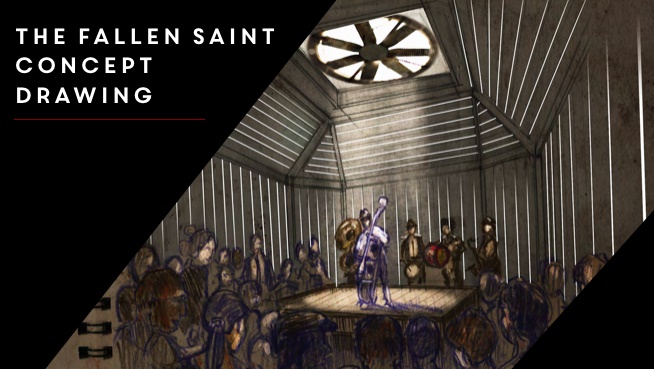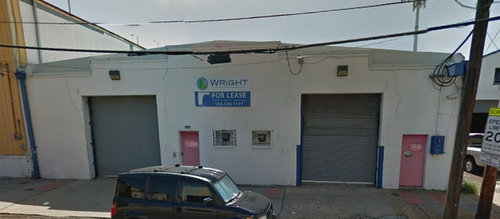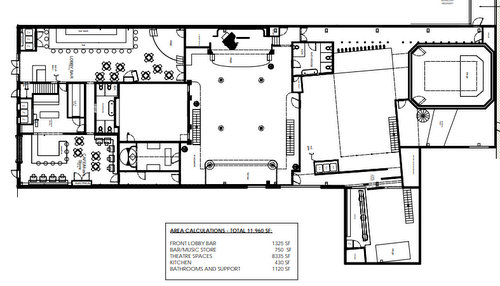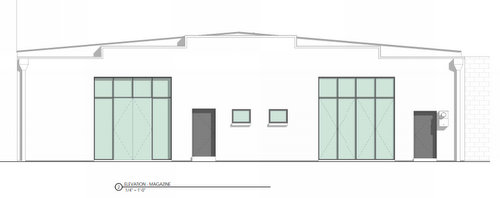
Early concept art for one of the performance spaces in “The Fallen Saint,” an immersive theatre production slated for the warehouse at 1152 Magazine Street. (courtesy of Proximity Entertainment)
A new form of avant garde immersive theatre popular in New York City is seeking to make a Magazine Street warehouse its home in New Orleans, producers of the project told Lower Garden District neighbors this week.
“The Fallen Saint” will combine live music and theatre in a series of intimate settings inside the warehouse at 1152 Magazine Street, said Seth and Rosa Dunlap, the owners of the building. The building will also feature a full-service restaurant with live music that will operate even when the show is not running, they said.

The warehouse at 1152 Magazine Street is slated to be renovated into a venue for “The Fallen Saint” immersive theatre production. (via Google Maps)
Jennie Willink, who produced the popular “Queen of the Night” and has worked with the creators of “Sleep No More” to develop performance venues and entertainment concepts, is working with several of her former colleagues from earlier in her career at Blue Man Group to create the New Orleans project. The New York Times described “Queen of the Night” as “a circus of intimate sensation” in 2014 and “Sleep No More” as “a voyeur’s delight” in 2011.
While those productions drew from “MacBeth” and Mozart’s “Magic Flute,” “The Fallen Saint” will take early 20th Century New Orleans as its inspiration, leaning heavily into the jazz age through Prohibition.
“It’s not a historical piece. It’s more a celebration of the vibe, and energy and creativity that happened here around that time, and the influence it had on the rest of the world,” Willink said.
Rather than a single performance on stage, however, immersive theatre divides the audience into small groups, allowing them to wander through the six performance spaces and interact with the performers, Willink explained.
“It’s a show where the audience is invited into an environment and invited to explore,” Willink said. “There’s a few distinct performance spaces. They’ll be broken into small groups and they’ll be experiencing small live music performances, maybe a tap dance number or a theatrical piece. It’s a very intimate performance. Instead of sitting far away from the piano player and watching him on stage, you can actually squeeze up next to him and watch him play.”

The floor plan for “The Fallen Saint” shows the Magazine Street entrance at left.
The renovation will fit entirely within the 13,000-square-foot warehouse space, and will not require any expansions or additions to the building, Rosa Dunlap said. The theatre production will require, however, a conditional-use permit from the city for the bar, the live entertainment and the size of the venue, which requires City Council approval.
Each show will offer 250 tickets, and will usually only be one a day during the week, or a double on Fridays and Saturdays. Dinner at the 40-seat restaurant will be included in many of the ticket packages, staggering the arrival of guests in and out of the show itself.
The developers emphasized that the project is a dramatically different model from a concert, where everyone arrives at once and files in to hear the same thing at the same time. Some of the performance spaces are meant to hold as few as a dozen guests at a time, so the music in them will not be amplified, Willink said.
“The model only works if we can prevent the sound from bleeding from one space to the next, so by design they are all low-volume, intimate experiences,” the Dunlaps wrote in their application to the city.
The project’s application to the city was accompanied by endorsements from residents of the same block and immediate surroundings, owners of nearby businesses like St. Vincent’s Guest House and French Truck Coffee, and several members of the New Orleans cultural community, including Bruce Boyd Raeburn, history professor and curator of the Hogan Jazz Archive at Tulane University
“I believe that The Fallen Saint could be one of the best and most interesting experiences to come to New Orleans in a long time,” wrote Dr. Michael White. “It presents the opportunity to enjoy and participate in a unique program that utilizes our local musical traditions as the basis of hands-on learning and enjoyment. … In addition it could help the local economy by employing and encouraging dozens of talented local performers who can gain experience as well as earn a living.”

A rendering of the facade of “The Fallen Saint” building at 1152 Magazine. (via city of New Orleans)
Other neighbors, many of them longtime activists in Coliseum Square, said they were unsure about bringing 250 people at once, especially since no parking is available on the site. Longtime Coliseum Square activist John Boyd said the Dunlaps needed a more concrete plan for parking and other issues to ensure it doesn’t become a burden on neighbors over time.
“This is going to be a hit, and the hit’s going to be on my back,” Boyd said. “I’m living in what is the beginning of an adult Disneyland.”
The Dunlaps said they are still working through options with city planners on how to deal with parking, but noted that the majority of their patrons will likely arrive by cars for hire, like taxis or Uber.
Neighbor Laura Joffrion, however, noted that she had seen one of the company’s other shows in New York, and that it was a clearly a benefit to the surrounding neighborhood, rather than a nuisance.
“Everything that happens is extremely immersive from the point you walk in the door,” Joffrion said. “Their business model falls apart if its too noisy.”
Other neighbors expressed a more general apprehension at the uncertain future for such a large site once alcohol and live entertainment permits are added. The quality of life in the Lower Garden District has improved dramatically since the 1980s and ’90s when low-rent bars proliferated, they said, and they worried that if “The Fallen Saint” comes to an end, something less savory might take its place.
“If you get a variance, it stays there,” said Diana Johnson, a resident of the Lower Garden District since the early 1980s. “Many of you in this room were not even born when we moved into the neighborhood. You did not hear the gunfire every night.”
Seth Dunlap thanked those residents for their efforts on behalf of the neighborhood over the past years. As nearby residents themselves who have also been active in the neighborhood association, he and his wife hoped to continue that work through this project.
“If it wasn’t for you, we wouldn’t be standing here today,” Seth Dunlap said. “We live two blocks away. We have two children we’re raising this neighborhood. We are some of the closest direct residents with children of this block, and we don’t want a quality of tenant that’s going to disrupt our livelihood and disrupt our life.”
Lauren Averill, a Lower Garden District Association member who has been active in membership and fountain-maintenance efforts for several years, said she would be more worried if the Dunlaps hadn’t already been involved in the neighborhood. Instead, she said, they are raising their family right next to the project.
“The fact that the owners are here and are part of the community, that to me is a big deal,” Averill said.
Ultimately, the Lower Garden District Association opted not to take a vote on the project Monday night, asking the Dunlaps to return to their July meeting with more information about the parking plan for the building and a possible good-neighbor agreement. The City Planning Commission currently has an initial hearing on the project scheduled for its July 24 meeting.